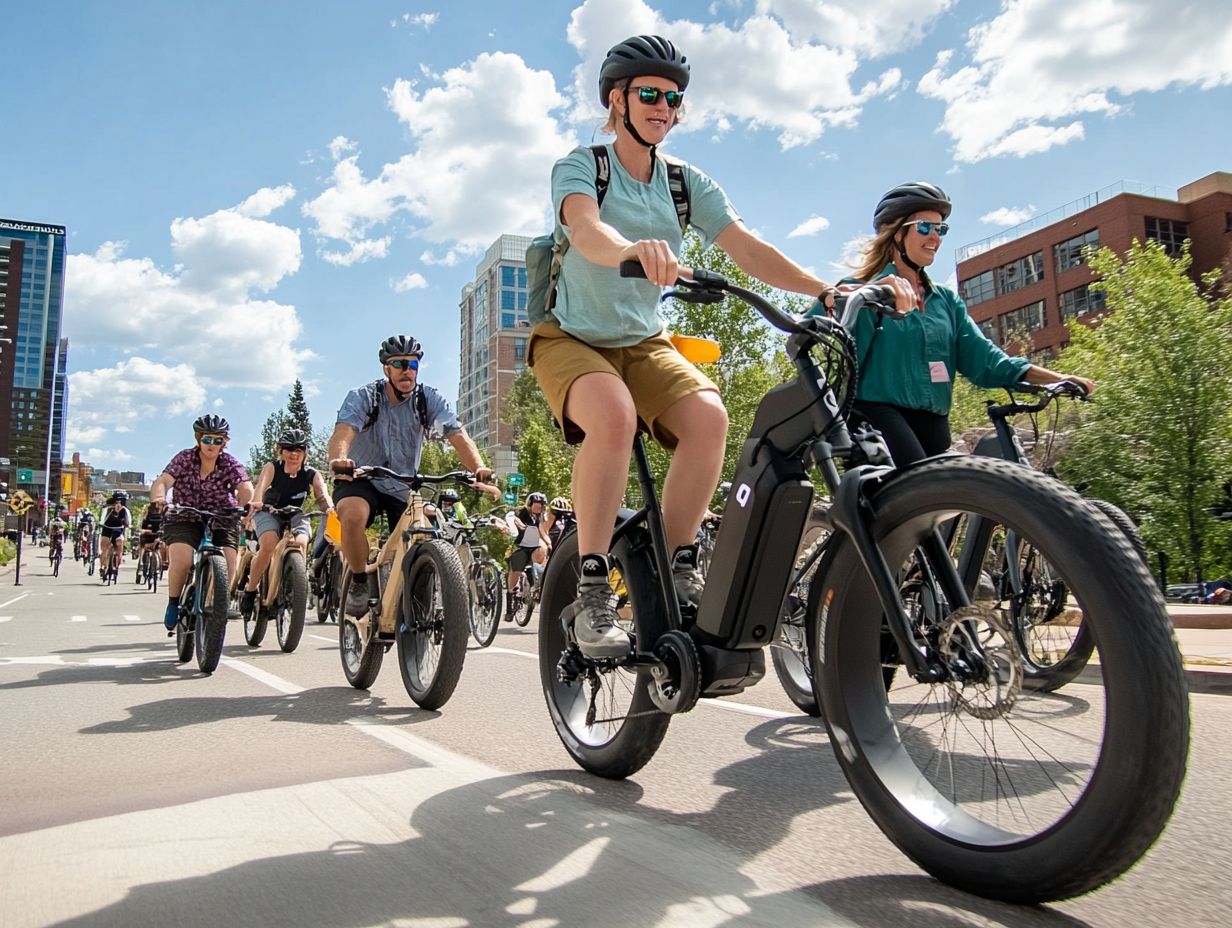The Importance of Following Electric Bicycle Laws
As electric bicycles continue to rise in popularity, it s crucial for you to grasp the laws governing their use, particularly the e-bike laws. Understanding these laws ensures your safety and compliance.
These laws are crafted to protect both riders and pedestrians, creating a safer environment for everyone on the road. This article explores the different classifications of e-bike laws. It highlights the safety benefits of following them and the potential consequences of not complying.
You’ll also find practical tips to keep you informed and help you navigate the regulations with ease. Whether you re a seasoned rider or just dipping your toes into the e-bike world, get ready to feel empowered to ride responsibly and confidently.
Contents
- Key Takeaways:
- Overview of Electric Bicycle Laws
- Safety Benefits of Following Electric Bicycle Laws
- Types of Electric Bicycle Laws
- Consequences of Not Following Electric Bicycle Laws
- Tips for Complying with Electric Bicycle Laws
- Frequently Asked Questions
- What are electric bicycle laws?
- Why is it important to follow electric bicycle laws?
- Do electric bicycle laws apply to all types of electric bicycles?
- What are some common electric bicycle laws that riders should be aware of?
- What are the consequences of not following electric bicycle laws?
- Where can I find information about electric bicycle laws in my area?
Key Takeaways:

- Following electric bicycle laws reduces risks and promotes safety for riders and others.
- Not following these laws can lead to legal and financial consequences.
- Staying informed about these laws helps avoid violations and ensures a safe riding experience.
Overview of Electric Bicycle Laws
Electric bicycle laws are crucial regulations that set rules for how you can ride e-bikes. They outline various classifications and safety standards to ensure you can ride safely on these increasingly popular electric mobility devices.
In California, laws like Assembly Bill 1774 and Assembly Bill 2234, along with AB 1778 and AB 1096, categorize e-bikes into Class I, Class II, and Class III. Each classification has its own set of rules regarding pedal-assist, throttle mechanisms, and e-bike safety.
Organizations such as CalBike champion regulations that prioritize rider safety and align with local ordinances. They highlight the pressing need for structured e-bike usage on public roads.
What are Electric Bicycle Laws?
Electric bicycle laws encompass a comprehensive set of regulations crafted to oversee the use, classification, and safety standards of electric bicycles, commonly known as e-bikes.
These laws are designed with your riding experience in mind. They tackle the distinctive challenges that come with this increasingly popular mode of transport. By laying out clear classifications based on speed and power output, these regulations define how you can legally use e-bikes on public roads. For more information, check out the 5 essential questions about e-bike laws. This minimizes the risk of accidents and ensures your compliance with local traffic rules.
Safety standards, such as mandatory helmet use and specific lighting system requirements, are in place to safeguard both you and pedestrians. This framework promotes responsible riding and fosters greater acceptance of e-bikes in urban settings. For more details, you can check understanding electric bicycle laws in California, creating a more harmonious coexistence on the roads.
Safety Benefits of Following Electric Bicycle Laws
Following electric bicycle laws offers a wealth of safety benefits for you and other road users alike. When you operate e-bikes in accordance with established safety standards, including helmet requirements and local ordinances, you not only enhance your own protection but also contribute to a reduction in accidents and injuries.
By embracing these regulations, you play a critical role in cultivating a safer environment for everyone on the road, especially in bustling urban areas like New York City and California. Implementing specific safety measures and guidelines is essential for navigating these dynamic landscapes with confidence and care.
Reducing Risks for Riders and Others

Implementing e-bike regulations significantly reduces risks for you and other road users by promoting safe riding practices and minimizing potential accidents.
These regulations include mandatory helmet usage and speed limit guidelines. These measures dramatically decrease the severity of injuries in the event of a crash. Studies show that states with helmet laws experience a 20% lower rate of head injuries compared to those without.
By embracing safe riding practices, like maintaining a safe distance from vehicles and following traffic signals, you help to reduce accidents on the roads. Communities that enforce these guidelines see significant improvements in overall safety, highlighting the critical role such regulations play in protecting both riders and pedestrians.
Types of Electric Bicycle Laws
Electric bicycle laws can be categorized into several types, focusing on e-bike classification systems. This outlines functionalities and permissible use across different regions, particularly in California.
- Class I: Offers assistance when pedaling, capped at 20 mph.
- Class II: Equipped with a throttle, allowing you to use the electric motor without pedaling, also capped at 20 mph.
- Class III: Fast e-bikes that support pedaling up to 28 mph. They may require additional safety gear, such as mandatory helmet use in certain areas.
Understanding these classifications is essential for riders and regulatory bodies alike. It ensures compliance and fosters safe riding practices.
Classifications and Regulations
E-bike classification encompasses three main categories: Class I, Class II, and Class III. Each has its own regulations regarding operation and use.
Understanding these classifications is key for you as a rider, as they dictate where and how you can ride.
Familiarizing yourself with these distinctions allows you to navigate local laws with confidence and enhances your overall riding experience.
Consequences of Not Following Electric Bicycle Laws
Ignoring electric bicycle laws can lead to serious consequences, including legal issues and significant financial penalties, especially for modifications that breach regulations.
Neglecting to follow safety standards may result in fines, legal action, or even restrictions on your ability to ride e-bikes in places like California or Marin County.
These potential repercussions highlight the importance of understanding and complying with e-bike regulations, including key legal considerations for electric bicycle riders, fostering safe and responsible riding practices for everyone.
Possible Legal and Financial Ramifications

The legal and financial consequences of violating e-bike laws can be severe, resulting in fines, lawsuits, and the risk of losing your riding privileges.
Don t risk it! Fines can hit you hard, ranging from $25 to $200, depending on your state s regulations a clear reminder of the importance of safety gear.
If you modify your e-bike to exceed speed limits or ignore essential equipment requirements, you may face hefty citations and even lawsuits from accident victims.
In California, fines can escalate dramatically with repeat offenses. It s in your best interest to stay informed and compliant to enjoy your rides without worry.
Check your local regulations to stay safe!
Tips for Complying with Electric Bicycle Laws
Complying with electric bicycle laws is essential for your safety and for steering clear of any legal troubles. There are several tips to help you stay informed about e-bike regulations, including helmet requirements and local ordinances.
It’s wise to regularly check for updates from local authorities and organizations like CalBike to ensure you’re aware of any changes that could impact your riding experience. By embracing safe riding practices and Understanding Electric Bicycle Safety Regulations, you can fully enjoy your electric bicycle while staying within the bounds of the law.
How to Stay Informed and Avoid Violations
To stay informed and avoid violations of electric bicycle laws, you should actively seek out resources and updates from local authorities and advocacy groups. This proactive approach not only enhances your understanding of the evolving regulatory landscape but also cultivates a sense of community among fellow enthusiasts.
Engaging with local news sources provides timely updates on legislative changes. Joining e-bike advocacy groups gives you important insights and unwavering support. Regularly checking government websites ensures that you have access to the most current information straight from the source.
By taking these steps, you can confidently navigate the legal complexities of e-biking, ensuring both your safety and compliance with the law.
Frequently Asked Questions
What are electric bicycle laws?
Electric bicycle laws are regulations that govern the use of electric bicycles on public roads and pathways. These laws vary by country and state and typically cover speed limits, safety equipment, and where electric bicycles can be ridden.
Why is it important to follow electric bicycle laws?
Following electric bicycle laws keeps you safe and avoids penalties! These laws are designed to protect riders, pedestrians, and other vehicles on the road.
Do electric bicycle laws apply to all types of electric bicycles?
Yes, electric bicycle laws apply to all types of electric bicycles, including models that assist with pedaling and those activated by a throttle. Familiarizing yourself with the specific laws in your area is crucial, as they may differ based on the type of electric bicycle you are using.
What are some common electric bicycle laws that riders should be aware of?
Common electric bicycle laws include a maximum speed limit of 20 mph, requiring riders to wear a helmet, and having a valid driver’s license or permit to operate an electric bicycle on public roads. Other laws may include age restrictions, bans on riding on sidewalks, and using lights and reflectors when riding at night.
What are the consequences of not following electric bicycle laws?
The consequences can vary depending on the specific law broken and the location. Riders may receive a warning or a fine. In more serious cases, they may face legal action or have their electric bicycle impounded.
Where can I find information about electric bicycle laws in my area?
You can find information about electric bicycle laws in your area by checking your local government’s website or contacting your local transportation department. Reaching out to electric bicycle advocacy groups is also a great way to gather more information and resources.





